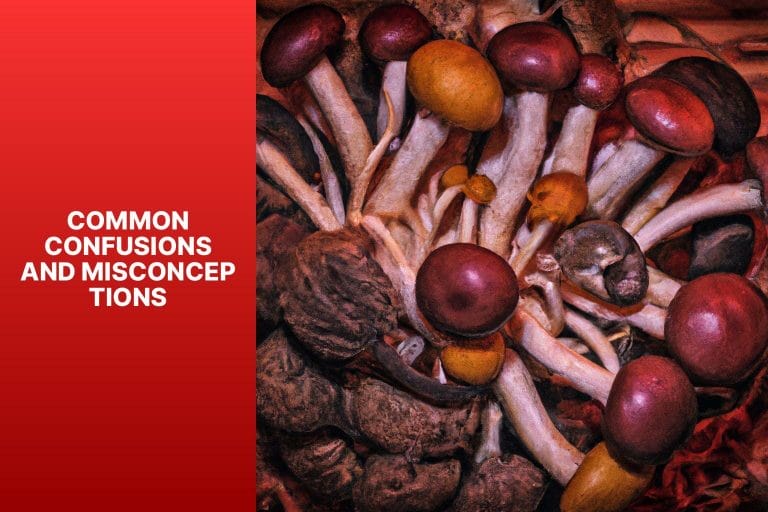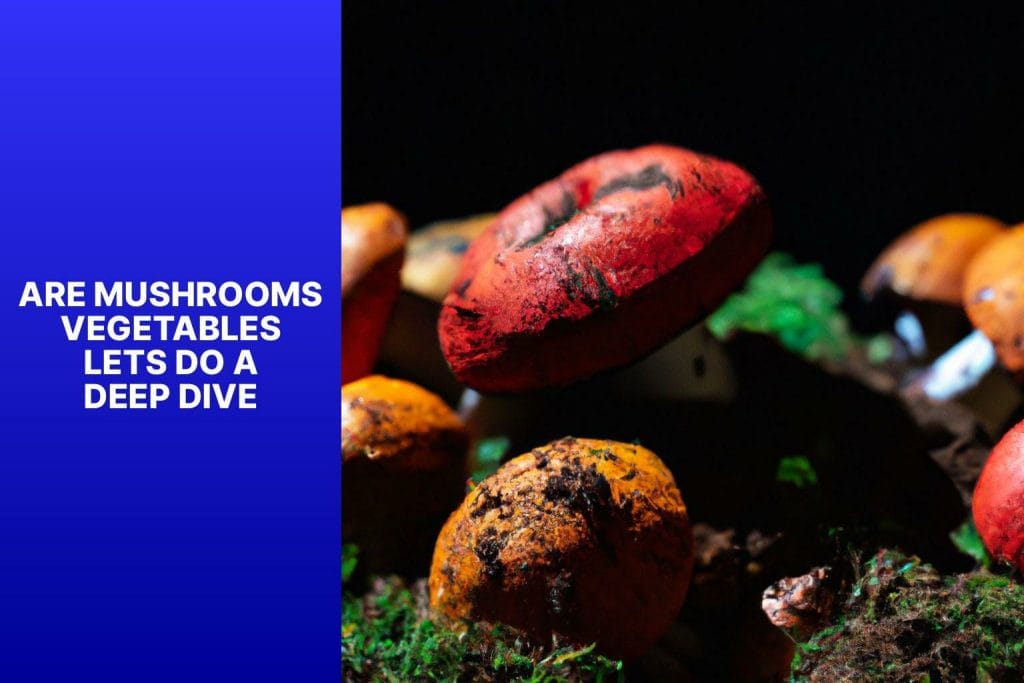Mushrooms have always been a subject of curiosity and confusion regarding their vegetable classification. To shed light on this topic, it is essential to delve into the characteristics and nature of mushrooms.
Let’s explore whether mushrooms are considered vegetables or not.
Introduction to Mushrooms:
Mushrooms are unique organisms that belong to the fungi kingdom. They come in various shapes, sizes, and colors and are widely used in cooking for their distinctive flavors and textures. The question of whether mushrooms can be classified as vegetables is a matter that requires a deeper understanding.
Classification of Mushrooms:
To determine whether mushrooms are vegetables, it is crucial first to explore the classification and nature of these organisms. Are mushrooms classified as plants or fungi? To answer this question, we must clarify what constitutes a vegetable and what differentiates fungi from plants.
Are Mushrooms Plants?
Contrary to popular belief, mushrooms are not classified as plants. They belong to the fungi kingdom, which is a separate classification entirely. While plants use photosynthesis to produce food, fungi extract nutrients by breaking down organic matter in their environment.
What Makes a Vegetable?
Understanding what makes an organism a vegetable is essential to determine whether mushrooms fall into this category. In a culinary context, vegetables are typically defined as edible parts of plants, such as roots, stems, leaves, or fruits, that are consumed for their nutritional value.
Mushrooms as Fungi:
As mentioned earlier, mushrooms are classified as fungi. Fungi are distinct organisms with unique characteristics that set them apart from plants.
What Are Fungi?
Fungi are eukaryotic organisms that obtain nutrients through absorption. They are known for breaking down organic matter and recycling nutrients in the ecosystem. Unlike plants, fungi do not have chlorophyll and do not perform photosynthesis.
Differences Between Plants and Fungi:
There are several key differences between plants and fungi. While plants have roots, stems, and leaves, fungi consist of mycelium and fruiting bodies like mushrooms. Fungi also have a different cell structure and reproductive mechanism compared to plants.
Are Mushrooms Considered Vegetables?
From a culinary perspective, mushrooms are often considered a vegetable due to their versatile use in cooking. Scientifically speaking, mushrooms are not classified as vegetables but as a separate food group within the fungi kingdom.
Vegetable Definition in Culinary Context:
In culinary terms, vegetables are broadly defined as edible plant parts that are typically savory, served as a side dish, or used as ingredients in various dishes. While mushrooms do not meet the botanical definition of vegetables, they often fall into the culinary category of vegetables.
Nutritional Comparison: Mushrooms vs. Vegetables:
Regarding nutrition, mushrooms possess unique qualities that differentiate them from traditional vegetables. They are low in calories, rich in vitamins and minerals, and contain beneficial compounds like antioxidants and beta-glucans. It is important to note that the nutritional composition of mushrooms may differ from that of traditional vegetables.
Common Confusions and Misconceptions:
The confusion surrounding mushrooms being classified as vegetables arises from the similarities in culinary use and the presence of umami flavors commonly associated with savory vegetables. Due to their meaty texture, mushrooms are often used as alternatives to meat in vegetarian and vegan dishes.
Mushrooms as a Unique Food Group:
By delving into mushrooms’ classification, nature, and culinary usage, we can better understand their place within the food world and appreciate their distinct qualities as a culinary delight and a remarkable organism in the fungi kingdom.
Key takeaway:
- Mushrooms are classified as fungi, not plants: While mushrooms may be similar to vegetables in some ways, they are classified as fungi, belonging to a separate kingdom in the biological classification.
- Vegetables are defined differently in a culinary context: Culinary definitions of vegetables may vary, and some definitions may include mushrooms as vegetables. Botanically speaking, mushrooms are not considered vegetables.
- Mushrooms offer unique nutritional benefits: Mushrooms contain various nutrients and can provide a range of health benefits. Although they may not fit the traditional definition of vegetables, mushrooms can still be a valuable addition to a balanced diet.
Classification of Mushrooms
| Classification | Description |
| Edible Mushrooms | Mushrooms are safe to consume and widely used in cooking—examples: button mushrooms, shiitake mushrooms, and oyster mushrooms. |
| Medicinal Mushrooms | Mushrooms are traditionally used for medicinal properties and are believed to have various health benefits. They are used in supplements and traditional medicine—examples: reishi mushrooms, Chaga mushrooms, and lion’s mane mushrooms. |
| Poisonous Mushrooms | Mushrooms contain toxins that can cause illness or death if ingested. Important to identify to avoid consumption. Examples: death cap mushroom, destroying angel mushroom. |
| Psychedelic Mushrooms | Mushrooms contain psychoactive compounds like psilocybin, inducing hallucinations and altered states of consciousness. Commonly known as “magic mushrooms,” and used for spiritual and recreational purposes—psilocybe cubensis, psilocybe semilanceata. |
Are Mushrooms Plants?
Mushrooms are fungi, not plants. Fungi constitute a distinct kingdom in the classification system. Unlike plants, mushrooms lack chlorophyll necessary for photosynthesis.
Instead, fungi obtain nutrients by decomposing organic matter or forming symbiotic relationships. Mushrooms have chitin-based cell walls, unlike plants with cellulose-based cell walls.
This difference in structure gives mushrooms a unique texture and enables them to release spores for reproduction.
Although mushrooms are not plants, they resemble vegetables in some ways. Are Mushrooms Plants? They are commonly used as a substitute in cooking, providing a savory and meaty flavor often favored by vegetarians and vegans.
Besides being low in calories and fat, mushrooms are a good source of dietary fiber and contain beneficial compounds like beta-glucans.
What Makes a Vegetable?
Vegetables are consumed for nutrition. They are low in calories and high in vitamins, minerals, and fiber. A vegetable is characterized by its parts and role in a balanced diet.
Vegetables come from edible parts of plants, like leaves, stems, roots, or flowers. They can be eaten raw or cooked and are important in cuisines worldwide.
Vegetables have a range of colors and flavors. They can be green, red, orange, or yellow and have various tastes, from bitter to sweet. These colors and flavors provide beneficial compounds like antioxidants, phytochemicals, and nutrients.
Vegetables are nutritious and contribute to a healthy diet. They are low in fat and carbohydrates but high in vitamins and minerals like C, A, potassium, and folate. Including various vegetables in your diet can improve digestion, boost immunity, and reduce the risk of chronic diseases.
Humans have been eating vegetables for thousands of years. Vegetable cultivation dates back to ancient civilizations like the Egyptians, Greeks, and Romans. Humans have selectively bred and cultivated plants over time to produce larger, more colorful, and more nutritious vegetables. Nowadays, vegetables are essential to our diets and are appreciated for their taste, versatility, and nutritional benefits.
Mushrooms as Fungi
Mushrooms, belonging to the kingdom of Fungi, are not plants and do not possess chlorophyll. Instead, mushrooms obtain their nutrients through the decomposition of organic matter. In terms of reproduction, mushrooms rely on spore production.
To delve deeper into the concept of mushrooms as fungi, a wider exploration can be conducted. This exploration may involve studying the role of mushrooms in various ecosystems, examining their unique biochemical properties, and expanding knowledge on the vast diversity of mushroom species found worldwide.
What Are Fungi?
Fungi are diverse organisms that play important roles in nature.
They are separate from plants and animals, with their distinct kingdom.
Fungi have unique cell structures and obtain nutrients externally. They have cell walls made of chitin, unlike plants with cell walls made of cellulose.
Fungal cells contain nuclei, mitochondria, and other organelles like plant and animal cells.
Unlike plants, fungi are heterotrophic organisms. They get their nutrients by breaking down organic matter or forming mutualistic relationships.
Fungi reproduce through spores which can form new colonies and adapt to different environments.
Fungi have various ecological roles, like nutrient cycling, decomposition, and plant symbiotic relationships. They can be found in different habitats, including soil, wood, and the human body.
Understanding fungi’s unique characteristics is important for studying their ecological and biological importance in ecosystems. Fungi contribute to our planet’s biodiversity through their diverse forms and functions.
Differences Between Plants and Fungi
| Criteria | Plants | Fungi |
| Cell Structure | Plants contain cellulose cell walls | Fungi contain chitin cell walls |
| Nutrition | Plants produce their food through photosynthesis | Fungi obtain nutrients by absorbing organic matter from their environment |
| Reproduction | Plants reproduce through seeds or spores | Fungi reproduce through spores |
| Mobility | Plants are generally stationary | Fungi are mostly immobile, except for some types |
| Presence of Chlorophyll | Plants contain chlorophyll for photosynthesis | Fungi do not contain chlorophyll |
| Role in Ecosystem | Plants are producers in the food chain | Fungi are decomposers and recyclers of organic matter |
Pro-tip: Understanding the differences between plants and fungi is important for categorizing organisms correctly. They may have some similarities, such as their immobility and ability to reproduce using spores, but their cell structure, nutritional methods, and role in ecosystems set them apart. Recognizing these distinctions can provide a deeper understanding of our planet’s diverse life forms.
Are Mushrooms Considered Vegetables?
When it comes to mushrooms, there’s an ongoing debate: are they truly vegetables?
This section unravels the mystery and explores the various aspects of determining whether mushrooms can be classified as vegetables.
From understanding the culinary context of vegetable definitions to a nutritional comparison between mushrooms and traditional vegetables, get ready to discover the truth about mushrooms and their categorization in the food world.
Prepare to be surprised by what you learn!
Vegetable Definition in Culinary Context
In the culinary context, vegetables are edible plant parts that add flavor, texture, and color to meals. They are typically consumed for their nutritional value. However, mushrooms should not be considered vegetables.
They belong to the fungi kingdom and have a distinct texture and taste. Despite this, mushrooms are appreciated for their earthy flavor and meaty texture, making them a versatile ingredient for vegetarian and non-vegetarian meals.
It is worth noting that although mushrooms are not considered vegetables, they still offer various health benefits. They are low in calories and fat but rich in essential nutrients like vitamins, minerals, and antioxidants. Additionally, mushrooms are a good source of fiber and can be a great addition to a balanced diet.
Understanding the difference between vegetables and mushrooms can help you make more informed choices in your cooking. Remember, mushrooms are unique and distinct from vegetables, but they can still be a delicious and nutritious addition to your meals when exploring different culinary recipes and menus.
Nutritional Comparison: Mushrooms vs. Vegetables
Here is a nutritional comparison between mushrooms and vegetables:
Some mushrooms we studied have 22 calories, 3g of protein, 4g of carbohydrates, 1.5g of fiber, 0.3g of fat, 2mg of vitamin C, seven mcg of vitamin K, and 318mg of potassium per serving.
Vegetables, on the other hand, have varying nutritional content depending on the specific vegetable. The calories, protein, carbohydrates, fiber, fat, vitamins, and minerals can vary depending on the type and preparation.
When comparing its nutritional value to mushrooms, it is important to consider the specific vegetable.
Common Confusions and Misconceptions

Photo Credits: True2Mushrooms.Com by Jose Smith
If you’ve ever wondered whether mushrooms should be classified as vegetables, you’re not alone. This section unravels the common confusions and misconceptions surrounding this debate.
We’ll explore the intriguing similarities between mushrooms and vegetables and how mushrooms have emerged as a popular meat alternative. So, get ready to dive deep into this topic and unravel the fascinating world of mushrooms!
Similarities Between Mushrooms and Vegetables
Mushrooms and vegetables share some similarities in terms of their properties and benefits.
Both mushrooms and vegetables are edible and can be used in various recipes. They are also rich sources of dietary fiber and low in calories, making them suitable for inclusion in a healthy diet.
They contain important nutrients, vitamins, and minerals essential for a balanced diet.
In addition, some vegetables, like tomatoes, offer a unique umami flavor, similar to mushrooms.
Both mushrooms and vegetables have unique characteristics and can be enjoyed as a nutritious and flavorful diet.
Mushrooms as Meat Alternatives
Incorporating mushrooms as a meat alternative provides a flavorful and nutritious option for those reducing their meat intake or following a plant-based diet. Mushrooms can be a good meat substitute for several reasons.
Texture: Mushrooms imitate the chewiness of meat in dishes like burgers, tacos, and stir-fries, making them a suitable replacement.
Rich flavor: Certain types of mushrooms, like portobello or shiitake, can add depth to vegetarian or vegan meals, enhancing the taste.
Nutritional value: Mushrooms are low in calories and fat but rich in essential nutrients. They are packed with vitamins, minerals, and antioxidants, making them a healthy choice. What’s more, they provide dietary fiber and can serve as a good source of protein.
Versatility: Mushrooms can mimic the taste and texture of various types of meat. They can be grilled, roasted, sautéed, or used in recipes like mushroom-based meatballs or mushroom and lentil shepherd’s pie.
Sustainability: Replacing some meat-based meals with mushrooms has positive environmental impacts. Mushrooms require fewer resources and produce fewer greenhouse gas emissions than traditional livestock farming.
Whether you’re a vegetarian, vegan, or want to try something new, mushrooms offer a tasty and versatile alternative to meat in many dishes. So why not give mushrooms a try as a meat substitute?
Some Facts About “Are Mushrooms Vegetables? Let’s Do A Deep Dive”:
- ✅ Mushrooms are scientifically classified as fungi and not true vegetables. (Source: Our Team)
- ✅ The U.S. Department of Agriculture considers mushrooms to be vegetables in terms of nutrition. (Source: Our Team)
- ✅ Mushrooms are a good source of niacin, pantothenic acid, selenium, copper, and riboflavin. (Source: Our Team)
- ✅ Mushrooms do not have chlorophyll and derive nutrients from dead or living plants. (Source: Our Team)
- ✅ Mushrooms are not technically fruits, but they are closer to fruiting vegetables. (Source: Our Team)


